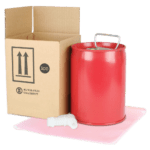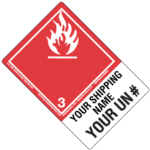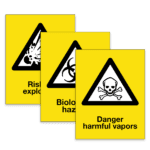
U.S. CPSC to Require Safety Devices on Consumer Containers for Flammable Liquids
Every year, thousands of people in the United States and Canada suffer severe burns due to flammable liquids. Most commonly, this involves flammable fuels such as gasoline, lighter fluid and other petroleum products. The U.S. Consumer Product Safety Commission (CPSC) is taking steps to prevent these injuries and improve protection for consumers.
The Problem
The main problem with consumer use of flammable liquids is their ability to evaporate and form a flammable cloud of vapor. Any ignition source within that cloud can ignite the vapors, leading to a flash fire. Further, the ignited vapors can then lead back to the container, causing ignition of the liquid within. This can force out burning liquid and vapour in an effect called “flame jetting,” with a terrifying blowtorch-like effect. Severe injuries or even death are likely for people in the area of the flame jet.
Until recently, experts thought flame jetting wouldn’t be a common danger to consumers, since the fuel-to-air ratio inside a typical consumer container wouldn’t be in the flammable range. However, the Bureau of Alcohol, Tobacco and Firearms (ATF) performed a study that showed how easily the vapours in a typical container could be ignited if the user tried to use the contents to start or accelerate a fire. Flame jetting was recognized as a serious risk to the public.
The Solution
Of course, the best solution is an informed consumer who knows how dangerous it is to bring flammable fuels around any sort of ignition source. But unfortunately, many consumers will still try to use liquids in gasoline cans and other containers as a way to start barbeques and bonfires, or even worse, pour them on already-burning fires as an accelerant. Luckily, there is a technological solution to prevent flame jetting, called a “Flame mitigation device” (FMD).
There are a number of methods of mitigating the ignition of fuels. CPSC says a “common type of flame mitigation device used with portable fuel containers is a flame arrestor (also known as flame arrester or flash arresting screen).” A flame arrestor is a metallic or plastic screen fitted to the mouth of the container. This cools the flames reaching the mouth so that the fire cannot pass through into the container.
The CPSC has already recognized three voluntary safety standards on FMDs, from the American Society for Testing Materials (ASTM) and the American National Standards Institute (ANSI). These standards are:
- ASTM F3326-21, Standard Specification for Flame Mitigation Devices on Portable Fuel Containers;
- ANSI/CAN/UL/ULC 30:2022, Standard for Safety Metallic and Nonmetallic Safety Cans for Flammable and Combustible Liquids and;
- ASTM F3429/F3429M-20, Standard Specification for Performance of Flame Mitigation Devices Installed in Disposable and Pre-Filled Flammable Liquid Containers.
But up to now, these standards have been strictly voluntary. Now, the CPSC will make those standards mandatory on “portable fuel containers.”
Note that “portable fuel containers” does not refer to containers such as hazardous materials packaging for transport. The CPSC defines portable fuel containers as:
“Any container or vessel (including any spout, cap, and other closure mechanism or component of such container or vessel or any retrofit or aftermarket spout or component intended or reasonably anticipated to be for use with such container):
- Intended for flammable liquid fuels with a flash point less than 140 degrees Fahrenheit, including gasoline, kerosene, diesel, ethanol, methanol, denatured alcohol, or biofuels;
- That is a consumer product with a capacity of 5 gallons or less; and
- That the manufacturer knows or reasonably should know is used by consumers for transporting, storing, and dispensing flammable liquid fuels.”
So it’s clear that this is aimed at containers for consumer use, not professional use or transportation.
Consumer containers such as these may be sold pre-filled with a liquid or empty. Suppliers of such containers must comply with these standards by July 12, 2023. Of course, most suppliers are likely to be already complying with these standards voluntarily.
Conclusion
Consumers using these containers should be aware of the dangers of bringing flammable liquids near flames and ensure that new cans they purchase meet these standards. Older containers without flame mitigation devices should not be used near ignition sources.
Do you have any questions about packaging standards or the safe handling of chemicals?
Our team of Regulatory Experts is just a call away for our customers at 855.734.5469 or send us an email, we’re happy to help.
Stay up to date and sign up for our newsletter!
We have all the products, services and training you need to ensure your staff is properly trained and informed.
 Fuel Shipping Kits Fuel Shipping Kits |
 Hazard Class 3 Flammable Liquid Shipping Name Label |
 Chemical Awareness signs |
References:
Federal Register, Determinations Regarding Portable Fuel Container Voluntary Standards Under the Portable Fuel Container Safety Act, Docket No. CPSC-2022-0017
CPSC, CPSC Requires Lifesaving Flame Mitigation Devices on Gas Cans and Other Portable Fuel Containers
PBS, “Small Bottle, HUGE Fireball (How Flame Jetting Works)”
The Portable Fuel Container Manufacturer’s Association, FAQ, Flame Mitigation Devices
Reiff Law Firm, Summer Hazards: Is Your Red Gas Can a Time Bomb?





